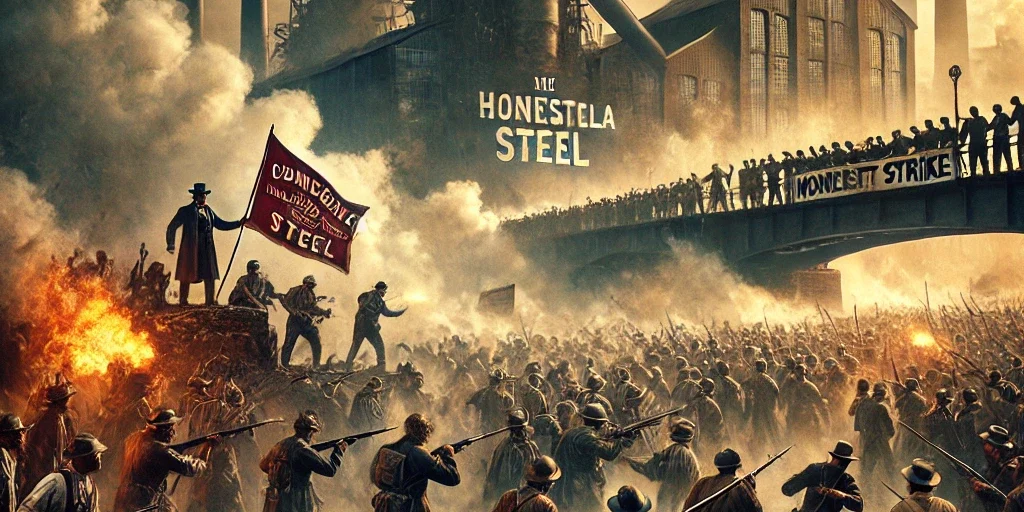The Homestead Strike of 1892
Few events in American labor history carry the weight and lasting impact of the Homestead Strike of 1892. A brutal clash between steelworkers and industrialists, this strike was more than just a labor dispute—it was a battle over power, wages, and the future of organized labor in the United States. Taking place at Andrew Carnegie’s Homestead Steel Works, the strike pitted thousands of workers against Carnegie’s ruthless business partner, Henry Clay Frick, resulting in bloodshed, a national spectacle, and a turning point in American labor relations.
The Roots of Conflict
In the late 19th century, Pittsburgh was the heart of the steel industry, and Carnegie Steel was its crown jewel. Workers at the Homestead Steel Works, located along the Monongahela River, had fought hard to form a union under the Amalgamated Association of Iron and Steel Workers (AAISW), one of the strongest labor unions of its time. While previous disputes had been settled through negotiations, a storm was brewing as the expiration date of the union’s contract approached in 1892.
Andrew Carnegie, despite publicly supporting workers’ rights and shorter hours, had no interest in letting unions control his operations. Instead, he left Henry Clay Frick in charge of handling labor disputes while he vacationed in Scotland. Frick, known for his brutal anti-union tactics, sought to break the union and cut wages, setting the stage for a showdown.
The Strike Begins
On June 29, 1892, after Frick announced sweeping wage cuts, workers at Homestead went on strike. In response, Frick locked them out of the plant and erected a massive three-mile-long fence topped with barbed wire around the mill, turning it into a fortress. The workers, outraged by these actions, took control of the town, preventing strikebreakers from entering and organizing themselves into an armed resistance.
Frick, determined to crush the strike, hired 300 Pinkerton agents, private security forces known for their willingness to violently suppress labor uprisings. Their mission was clear: retake the Homestead mill by any means necessary.
The Battle of Homestead
In the early hours of July 6, 1892, the Pinkertons arrived on barges along the Monongahela River, attempting to land at Homestead under the cover of darkness. But the workers were waiting. Armed with rifles, clubs, and even makeshift weapons, thousands of striking steelworkers and their families lined the riverbanks.
As the Pinkertons disembarked, gunfire erupted, and an all-out battle ensued. The workers and townspeople, fueled by anger and desperation, fought fiercely, using everything from dynamite to flaming oil-soaked rafts to repel the Pinkertons. After hours of intense fighting, the agents surrendered.
By the end of the battle, at least ten people were dead—seven workers and three Pinkertons—with dozens more wounded. The victorious workers celebrated, believing they had secured their mill and their future. But their victory would be short-lived.
Government Intervention and the Fall of the Strike
While the workers had won the battle, they hadn’t won the war. The strike had drawn national attention, and Pennsylvania’s governor, Robert Pattison, under pressure from Frick and industrial leaders, sent 8,000 state militia troops to Homestead on July 12. Faced with overwhelming force, the workers were unable to hold their ground.
By the end of July, Carnegie Steel had regained control of the plant. Frick, refusing to reinstate the unionized workers, hired non-union laborers to restart production. The strike officially collapsed in November 1892, and the once-powerful Amalgamated Association of Iron and Steel Workers was essentially crushed.
The Aftermath and Legacy
The Homestead Strike was a devastating loss for organized labor. The steel industry remained union-free for the next four decades, as companies across the country followed Carnegie’s lead in resisting labor movements. The defeat also showed how corporations could use private security forces and government intervention to suppress worker uprisings, setting a precedent for future labor conflicts.
Despite its tragic end, the Homestead Strike became a symbol of working-class resistance and the struggle for fair wages and conditions. Today, the Carrie Blast Furnaces and Homestead Pump House serve as historic reminders of this pivotal event.
A Fight That Still Echoes Today
The Homestead Strike of 1892 wasn’t just about one steel mill—it was about the fundamental question of who holds power in American industry. The courage of the steelworkers who stood up to Carnegie and Frick remains an enduring chapter in the history of labor rights.









